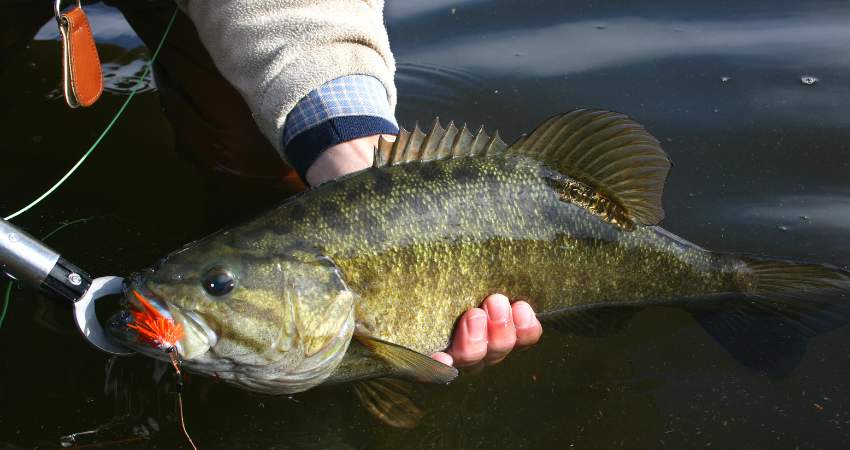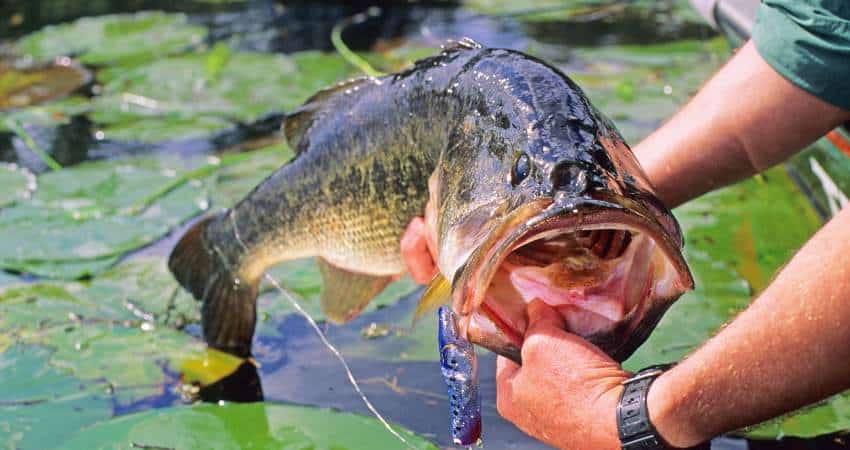Bass vs Catfish – What’s The Difference? Is Catfish Better?
Bass and catfish share many of the same waters. For this reason many people wonder about their differences. Let’s answer, what is the difference between bass and catfish?
Bass and catfish are different families and species of fish. Catfish grows larger and weighs more. Freshwater bass provides more minerals, protein and omega-3 fatty acids than catfish while catfish provides more B vitamins. Freshwater bass contains more mercury than catfish.
This article will compare their tastes, textures, cooking methods, costs, mercury levels and whether one can substitute for the other in recipes. In addition, I’ll do a side-by-side comparison of their habitats, size, weight and discuss their nutritional benefits.
Bass vs Catfish
When comparing both, the species of each has to be determined to make an accurate comparison. Catfish are a diverse group of ray-finned fish from different habitats and many different species. The most common catfish in North America are the channel catfishes.
Bass, like catfish, is a name shared with many different species. There are sea and freshwater. More common freshwater which can be found near channel catfish are largemouth, smallmouth and spotted.
This article will mainly focus on the channel catfish, smallmouth, largemouth and spotted. How can you tell them apart?
The easiest way to tell bass from catfish is by their body shape, scales and mouth. The catfish’s body is wider and flattened compared to the rounder bass. A catfish’s mouth is wider and is surrounded by whisker like barbells which bass don’t have. Bass have scales and catfish don’t have scales, just soft skin.
Scientific Classifications, Families, Species
Spotted bass are from:
- Family: Centrarchidae
- Genus: Micropterus
- Species: M. punctulatus
- Common nicknames: Spotty, spots.
Smallmouth bass are from:
- Family: Centrarchidae
- Genus: Micropterus
- Species: M. dolomieu
- Common nicknames: Brown bass, brownie, small, bronze and bronze back.
Largemouth bass are from:
- Family: Centrarchidae
- Genus: Micropterus
- Species: M. salmoides
- Common nicknames: Green bass, bigmouth, largies, bucketmouth.
Channel catfish are from:
- Family: Ictaluridae
- Genus: Ictalurus
- Species: I. punctatus
- Common nicknames: Channel cats, cats.
Habitats
Spotted
- Native to the Mississippi River and across the Gulf states from Texas to Florida. In addition, they are found in the western Mid-Atlantic states. They have been introduced to Virginia, North Carolina and southern Africa.
- They prefer warmer waters with strong currents and turbulence.
- Also, they prefer clear, open waters.
- When fishing they are commonly found in reservoirs and streams.
Smallmouth
- Native to the upper and middle Mississippi River Basin, the Great Lakes, Saint Lawrence River and the Hudson Bay Basin in Canada. They have been introduced into many cool-water rivers and lakes in the United States and Canada.
- They prefer colder waters.
Largemouth
- Native to the eastern and central United States, southeastern Canada and northern Mexico. They have been introduced into many other areas as well.
- They prefer warmer waters.
Channel Catfish
- Channel fish are native to lower Canada, eastern and northern United States and parts of northern Mexico.
- When fishing they can be found in rivers, reservoirs, lakes and even a pond.
Colors
- Spotted have a greenish gray body. They have dark, black spots forming a jagged horizontal line down the body.
- Smallmouth have a golden olive to brownish body. They have brown vertical bars or thick stripes down the body. The head has dark brown horizontal bars.
- Largemouth have a greenish gray body. They have dark, black blotches forming jagged horizontal lines down the body.
- Catfish channel have a darkened, grayish upper body with a light, silvery, white belly.
In open waters the smallmouth have a lighter color compared to a darker color when found in darker rivers.
Appearance
Dorsal Fins
- Spotted has two dorsal fins clearly connected to each other.
- Smallmouth have two dorsal fins separated by a shallow notch. The front dorsal is shorter with spine rays. The second dorsal is taller with soft rays.
- Largemouth have two dorsal fins with no separation. The front dorsal is shorter with spine rays. The 2nd is taller with soft rays.
- Cats have one dorsal fin.
Mouth
- The spotted jaw does not extend past the eye line.
- The smallmouth protruding jaw doesn’t extend past the red or brown eyes.
- The largemouth upper jaw extends past the eye socket.
- Cats have a wide mouth, and the jaws meet before the eye line. Their mouths have four pairs of barbells or whiskers around the mouth.
Scales
- The scales on the spotted head are smaller than the ones on the remaining part of the body.
- The scales on a smallmouth are uniform across the body and head.
- The scales on a largemouth are uniform across the body and head.
- Cats have soft skin with no scales.
Tongue
- The spotted tongue has a course rectangular tooth patch at the center.
- The smallmouth can have a round patch of teeth on the tongue.
- The largemouth has a smooth tongue.
- Catfish have no tongue.
Size and Weight
- A spotted can grow up to 25 inches long and weigh up to 11 pounds. The average one is 8-15″ long and weighs 1-2 pounds.
- Smallmouth average 12-16 inches long and weigh up to 10 pounds.
- Largemouth average 15 inches and grow up to 20 pounds.
- Channel cats have compact and muscular bodies. They average 22 inches and 30 pounds but can grow up to 50 pounds.
Age
- Spotted average lifespans is 7 years.
- Smallmouth oldest reported age is 26 years.
- Largemouth average lifespans is 10-16 years.
- Catfish average lifespan is 14-16 years.
Diet
Spotted consume the following:
- Copepods
- Crustaceans
- Insects
- Crayfish
- Other smaller fish
Smallmouth consume the following:
- Crayfish
- Plankton
- Insects
- Other small fish
Largemouth consume the following:
- Crayfish
- Fish
- Frogs
- Insects
- Crustaceans
Channel catfish consume the following:
- Insects
- Crustaceans
- Mollusks
- Snakes
- Fish
- Snails
- Claims
- Frogs
- Small birds
- Plants
Fishing
Bass fishing requires dedication and of course some luck to catch. Largemouth are what most anglers target when fishing.
River fishing for smallies can result in a good fishing day. Spotted bass are more aggressive and fight. Use the same size lures, rod and plastics as largies.
Check your local State management for posted rules and regulations on the bass fishing season, quantity allowed and sizes allowed to catch and keep.
Tastes and Textures
One of the most important things people takes into consideration when choosing a fish or fishing is its taste. When comparing the two fish, how does their tastes compare?
Bass and catfish taste mild to sweet. Wild catfish may taste a little fishier and more similar to largemouth. Both have a firm texture. Catfish and largemouth are moister than smallmouth and spotted.
- Spotted has a mild to sweet taste. It is only slightly fishy but not overly strong. It’s much less fishier than a largemouth. The flesh is white and has a firm texture.
- Smallmouth has a mild to sweet taste. It is only slightly fishy but not enough to turn people away who don’t prefer a fishy taste. The flesh is white and has a firm texture.
- Largemouth has a strong flavor and is a little fishy, more than smallmouth. It has white flesh which can be watery but is firm and meaty.
- Catfish has a mild to sweet taste. Its texture is moist, firm and doesn’t have much flakiness. Wild cats may taste a little fishier than farmed.
I conducted original research about the tastes of both by polling my clients, readers and members of food groups. I asked which one tastes better?
- 57% said they preferred bass.
- 39% said they preferred cats.
- 4% said it didn’t matter.
I did more research on taste by setting up a blind taste test at home. Both were prepared the same way and the results mirrored the poll above.
Find out how trout compared in my recent article, Trout – What’s The Difference? Let’s Compare.
Channel and Bass Substitutions
When preparing recipes for dinner it’s not always possible to locate the type of fish in a store or while fishing. If you have one type, you may ask, can I substitute one for the other?
Bass and catfish can substitute for each other due to their similar textures and tastes. Both of them have a firm texture and a mild to sweet taste. Different fish meals made from either one can be cooked using similar methods like grilling, baking, broiling and frying.
Smallmouth substitutes:
- Freshwater trout
- Lake herring
- Mackerel
- Snapper
- Grouper
- Halibut
Spotted substitutes are:
- Halibut
- Grouper
- Snapper
- Freshwater trout
- Lake herring
- Mackerel
Largemouth substitutes:
- Tuna
- Bluefish
- Salmon
- Walleye
- Mahi mahi
- Black Sea
Catfish substitutes include the following:
- Striped
- Cod
- Haddock
- Tilapia
- Flounder
- Basa
When substituting always stick to the following:
- Same size and weight.
- Stick with similar fillets, whole fillet or cross section.
- Stick with skinless or skin when the recipe calls for one.
- Texture is more important for certain cooking methods. Like using a firmer texture when grilling1.
Check out all the differences between spotted and largemouth in my article, Spotted vs Largemouth: What’s The Difference?

For a complete comparison between smallmouth and largemouth bass check out my article, Smallmouth vs Largemouth: What’s The Difference?
Nutrition
Both of them provide a wide variety of nutrients, vitamins and minerals. Below is the nutrients contained in 4 ounces.
| Nutrient | Freshwater Bass, raw (4 Ounces) | Channel Catfish, raw (4 Ounces) |
| Calories | 129 | 108 |
| Fat | 4.2 g | 3.2 g |
| Saturated Fat | 0.9 g | 0.8 g |
| Cholesterol | 77 mg | 66 mg |
| Protein | 21 g | 19 g |
| Sodium | 79 mg | 49 mg |
| Omega-3 | 0.77 g | 0.53 g |
| B-6 | 0.1 mg | 0.1 mg |
| B-12 | 2.2 mcg | 2.5 mcg |
| Thiamin | 0.08 mg | 0.23 mg |
| Riboflavin | 0.08 mg | 0.08 mg |
| B5 | 0.8 mg | 0.8 mg |
| Iron | 1.6 mg | 0.3 mg |
| Niacin | 1.4 mg | 2.1 mg |
| Folate | 17.0 mcg | 11.3 mcg |
| Potassium | 403 mg | 405 mg |
| Magnesium | 34 mg | 26 mg |
| Phosphorus | 226 mg | 237 mg |
| Calcium | 90.7 mg | 15.8 mg |
| Zinc | 0.7 mg | 0.5 mg |
| Selenium | 14.2 mcg | 14.2 mcg |
Nutrient Sources2 ((Nutrition Value: Fish, raw, mixed species, fresh water, bass))3
Both of them contain a good number of minerals and vitamins. At first glance it’s difficult to determine which one provides more. Therefore, bass vs catfish, which one is healthier?
Bass is better than catfish due to its higher percentage of healthy omega-3 fatty acids. It provides more iron, folate, magnesium, calcium and zinc. Bass contains more protein, 21 grams per four ounces compared to catfish’s 19 grams.
Catfish is no slouch either and provides more B12, thiamin, niacin, potassium and phosphorus. Both of them have a similar number of selenium, B5, riboflavin and B6. It’s difficult to argue against either fish’s nutrient profile.
The omega-3 fatty acids are what separates the two. Keep reading the next section below about health benefits and find out why omega-3 fatty acids are important to your health.
I’ll try choosing bass first for the taste and omega-3s. If not, purchasing some catfish is fine with me.
Find out how channel catfish compared to blue catfish in my article, Channel Catfish vs Blue Catfish: What’s The Difference?

Mercury Levels
The EPA and The Food and Drug Administration have issued warnings and suggestions regarding mercury levels in fish and how often they should be consumed4. This is especially important for young infants, developing children and pregnant women.
They established a list of best, good choices and ones to avoid based on their mercury levels. Therefore, which one has more mercury?
Freshwater bass have higher levels of mercury than catfish. Catfish is listed on the FDA’s best choice of fish regarding mercury levels. Bass has been listed on some states advisory warnings in regards to high levels of mercury.
If you’re pregnant, breast feeding or has a young child, Always check with a physician prior to eating new foods or changing your dietary habits.
These mercury warnings can change over time or affect only a particular area or state. Please check with your local EPA and FDA for the current recommendations especially if you’re fishing5.
Check out the detailed comparison of the spotted and smallmouth in my article, Spotted vs Smallmouth: What’s The Difference?

Health Benefits
Both of them provide the same nutrients and therefore the same benefits. Although I broke down the benefits by which one offers the higher percentage of each nutrient ((FDA: Seafood Nutrition Facts)).
Bass Health Benefits
Omega 3 Fatty Acids
Bass provides more omega-3 per four ounces raw. Omega-3 fatty acids are heart healthy and help keep arteries healthy. The omega-3s may help with the following:
- Keeping bad cholesterol low.
- Keeping good cholesterol high.
- Reducing inflammation.
- Reducing plaque build-up.
- Lowering triglycerides
- Help keep the heart rhythms more normal.
DHA and EPA, two of the fatty acids, are associated with lowering blood pressure and improving the health of blood vessels ((National Center for Biotechnology: Marine Omega-3 Supplementation and Cardiovascular Disease)).
Studies suggest omega-3s can help reduce joint pain and stiffness in people with rheumatoid arthritis. They may also boost the effectiveness of anti-inflammatory drugs.

Calcium
Calcium is important for blood pressure and the heart. Harvard Health reports calcium helps maintain blood pressure because it helps to control the relaxing and tightening of blood vessels6.
Calcium also helps the following:
- Build and maintain strong bones.
- Muscles need calcium to function properly.
- Improve nerve function.
Magnesium
There are 34 mg of magnesium per four ounces provided by cats including white catfish. Magnesium calms and relaxes the whole body including blood vessels. Magnesium has been shown to help improve sleep related problems like insomnia ((National Institutes of Health: Magnesium)).
Magnesium helps keep blood pressure levels balanced and stable. A recent study researched 22 studies and concluded magnesium supplementation decreased diastolic and systolic blood pressure7.
Magnesium helps control muscle and nerve function, blood sugar and blood pressure.
In the muscles and heart, magnesium competes with calcium to help the muscles relax after contracting. When the body is low in magnesium, calcium can over stimulate the heart muscle’s cells causing a rapid or irregular heartbeat.
Folate
Folate, also known as B9. A deficiency in folate has been linked to depression in people with epilepsy. Low folate has been associated with an increased risk of depression8.
Folic acid (B9) can improve blood flow and help blood vessels to relax. In a study of over 3,000 women, the findings suggest that using folic acid containing supplements may lower the risk for high blood pressure during pregnancy and preeclampsia9.
Find out how channel catfish compared to flathead in my article, Channel vs Flathead: What’s The Difference?
Catfish Health Benefits
B Vitamins
The B vitamins provided include B1 (thiamin), B2 (riboflavin), B3 (niacin), B9 (folate) B6, B12 and B5. B vitamins help support the following:
- Energy levels.
- Red blood cells.
- Cardiovascular disease.
- Digestion.
- Nerve function.
- Brain function.
Phosphorus
Phosphorus has been shown in scientific research to help with the following:
- Muscle recovery after exercise.
- Muscle contraction.
- Help the body store and manage energy.
- Help the kidneys remove waste.
- Promote healthy nerve conduction.
- Promote teeth and bone strength.
Potassium
Potassium helps the body get rid of excess sodium which helps reduce fluid build-up. These help keep systolic and diastolic blood pressure lower ((American Heart Association: How Potassium Can Help Control High Blood Pressure)).
The more potassium you consume, the more sodium your body will lose. Consuming too much sodium or not enough potassium throws off the delicate balance the kidneys need to remove the excess water10.
According to Harvard Health, a number of studies have shown a connection between low potassium levels and increased blood pressure11.
Find out how bullhead compared to flathead in my article, Bullhead vs Flathead: The Differences.
FAQs
Will bass eat a catfish?
A bass will eat a catfish if it is small enough for the bass to consume. A bass will eat other small fish, crayfish, frogs, insects and crustaceans.
Do catfish compete with bass?
Catfish does compete with bass especially when they grow larger. A large cat will consume many fish and compete with bass and bluegill while sharing the same waters. A larger cat will also consume smaller bass.
If you have any questions about this article or other posts, don’t hesitate to email the details to us. You can find an email on our contact page. We’ll do our best to reply as soon as possible.
As a Certified Health Coach, many of my clients inquire about seafood. In addition to coaching clients about catfish and bass, I’ve purchased, researched and consumed both fish for over 20 years.
Read Next – More Fish vs Fish Articles!
Sea vs Cod – Is One Better? Let’s Compare
White Perch vs White Bass: Which Is Better?
Sea vs Salmon: Which Is Better?
White Bass vs Striped: The Key Differences
Sea vs Salmon: Which is Better?
Bullhead Catfish vs Channel Catfish: What’s The Difference?
Flathead Catfish vs Blue Catfish – What’s The Difference?
- Sea Grant North Carolina: Fish Flavors and Substitutions [↩]
- Nutrition Value: Fish, raw, wild, channel, catfish [↩]
- NutritionData: Fish, bass, fresh water, mixed species, raw [↩]
- FDA: Advice about Eating Fish [↩]
- National Center for Biotechnology Information: Mercury accumulation in largemouth bass (Micropterus salmoides) in a Florida lake [↩]
- Harvard Health: Key minerals to help control blood pressure [↩]
- National Center for Biotechnology Information: Effect of magnesium supplementation on blood pressure: a meta-analysis [↩]
- National Center for Biotechnology Information: Is Depression Related to Low Folate Levels in People with Epilepsy? An Observational Study and Meta-analysis [↩]
- Women And Birth: Folic acid supplement use and the risk of gestational hypertension and preeclampsia [↩]
- National Center for Biotechnology Information: The Effect of the Sodium to Potassium Ratio on Hypertension Prevalence: A Propensity Score Matching Approach [↩]
- Harvard Health: Potassium lowers blood pressure [↩]
